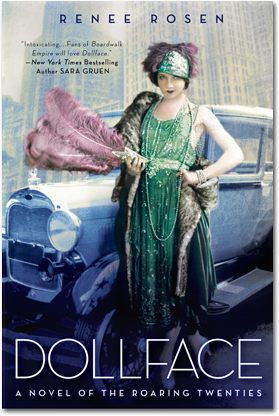
Women and Mobsters in the Jazz Age
YZM: Vera is every Jewish mother’s nightmare: a nice Jewish girl who moves away from home and takes up with gangsters. Who or what was your inspiration for this character?
RR: Vera wasn’t based on anyone in particular. She really developed on her own out of the times and out of what young women were doing with their lives in the 1920s. She came to me in bits and pieces and took on more definition with each draft. She was a tricky character to make sympathetic or relatable because she was so indecisive in the beginning and yet she taps into a core of strength that even she didn’t know she had. Hopefully readers will enjoy how she changes and grows throughout the story.
YZM: Were there many Jewish gangsters in Chicago during the 1920s? More than in other cities?
RR: There were Jewish gangsters all throughout the 1920s and in all cities. The key ones in Chicago would have been Jake “Greasy Thumbs” Gusak and Samuel ‘Nails” Morton. And of course people assume that Hymie Weiss was Jewish but he was a devout Catholic who had adopted a very Jewish-sounding name. Detroit was home to the predominately Jewish Purple Gang whom some believe was responsible for the St. Valentine’s Day Massacre. And of course New York’s key Jewish mobsters were Meyer Lansky, Arnold Rothstein and Bugsy Siegel.
YZM: Vera oscillates between two men, one Jewish and the other not. Did you have a particular goal in pitting a Jewish man against a non-Jewish one?
RR: Nothing conscious in terms of a goal. I just knew that she was going to be caught in the middle between two rival gang members. The fact that one of them happens to be Jewish only complicated matters for Vera. She felt a familiar bond with Shep because he was also Jewish. But beyond that, I really didn’t think of it as Jew pitted against a non-Jew. It really more of a North Sider pitted against a South Sider.
YZM: The Jewish Women’s Council gets significant play; can you say more about that group and its importance for Jewish women during that time?
RR: The Jewish Women’s Council was largely a fictional creation although Jewish women did form their own organizations—primarily because they weren’t always welcome in the other more established women’s groups. I wanted to bring the group into the book to show that Vera was really conflicted between being a gangster’s wife and being a Jewish wife, mother and homemaker. She wanted to be accepted by them but at the same time, she knew they could never identify with the realities of her life with the gangs.
YZM: The conclusion of the novel is somewhat open-ended; can you see continuing Vera’s story?
RR: I would love to revisit the Roaring Twenties. It’s really one of my favorite time periods but I think this might be the end for Vera. I can’t see doing a sequel that would have the same kind of action, the same kind of intensity. I do love Hannah but I right now I don’t see another novel growing out of that. BUT… I’ll never say never!
YZM: You have a novel coming out from New American Library next fall; is it also historical fiction?
RR: Yes, my new novel, What the Lady Wants is the story of Marshall Field and his 30 year illicit affair with his neighbor, Delia Caton. It spans from the Great Fire in 1871 to 1906 when Marshall Senior died. I go into the development of his famous department store, his issues with the labor unions that led to the Haymarket Riot and even the 1893 Columbian Exposition World’s Fair. So it covers a lot of ground in addition to the love affair and I’m very excited about this book as well!



